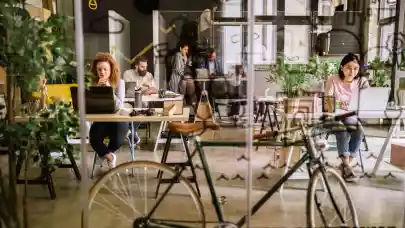
Desk sharing is beginning to take root in Czech offices. Not only does it make office space usage more efficient, but it also offers employees greater comfort. In fact, companies usually invest up to half as much in standard, individual workstations as they would in traditional office layouts, reports Colliers.
As the trend of working from home continues, companies are changing the face of their offices in the post-covid era. They are adapting these spaces to new ways of working and collaborating. Perhaps the biggest shift is the change in the ratio of space dedicated to individual work and to collaboration and networking. "While in pre-pandemic offices, 70% of office space was for individual workstations and 30% to meeting rooms and other areas, today the ratio is changing. 30-40% is to workstations; 60-70% to team collaboration, networking, eating or relaxing," explains Jana Vlková, Director of Workplace Advisory at Colliers. Workspaces themselves are also changing thanks to the rise in the volume of desk sharing, which is being introduced by a growing number of companies. "In practice, this means that a workstation that was previously designated for one employee can now be used by several people, which reduces the cost of renting and maintaining offices. Thanks to this, companies can invest more in these spaces and their equipment," says Jana Vlková, adding that employees can also use other spaces, such as creative zones or various informal zones, to diversify their work week, which still largely occurs in home offices.
More space, higher standards
In the traditional office layout, 10-12 sqm per desk was the usual norm; today, 14-16 sqm is the norm. However, when calculated per employee, this represents a reduction to 6-8 sqm. In fact, when sharing workstations, a ratio of 0.33-0.7 desks per employee is usually calculated. However, the increase in quality standards does not end with more space per workstation. Companies are also investing in better equipment. "While before the pandemic most orders were made for a medium to a lower standard, this year, on the contrary, most office spaces have already been designed to a higher standard; i.e. with adjustable desks, ergonomic chairs or quality lighting. There is also more investment in greenery and emphasis is often placed on more expensive natural materials. Of course, with the increase in hybrid work arrangements, there is also a bigger focus on technology," Jana Vlková notes. While the average cost of a workstation including a desk, office chair, lockable container, partitioning screen and lighting used to be around €1,000, today it is often only half that amount.
Offices reflect company culture
Although home offices still dominate the Czech office sector, this does mean the end of the traditional office. Greater investment in equipping those spaces is proof of that. The fact that they represent an important aspect in the decision-making process when accepting a job offer also plays a role. "According to ABSL data, 62% of employees work from home 2-4 days a week and 29% the entire week. Despite this, 19% of companies want to expand their offices. They want to create an attractive backdrop for work activities and an inspiring environment for their people; one that encourages creativity and communication between teams, while also giving a clear picture of the company's core values," concludes Jana Vlková. According to her, offices today are no longer just about space for individual work. Social interaction, knowledge exchange and support for company culture are much more important.



